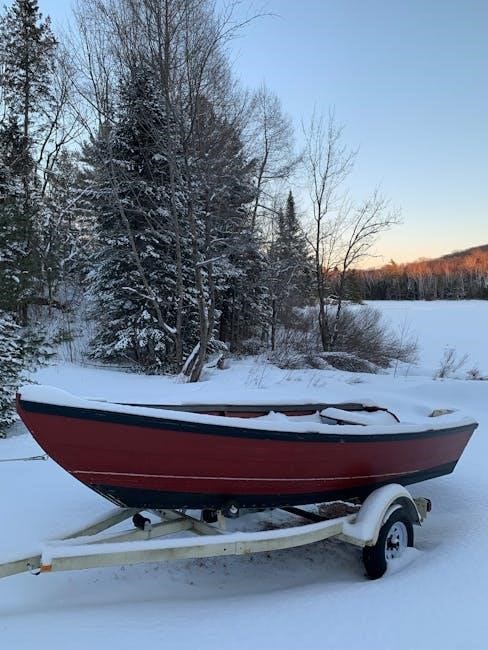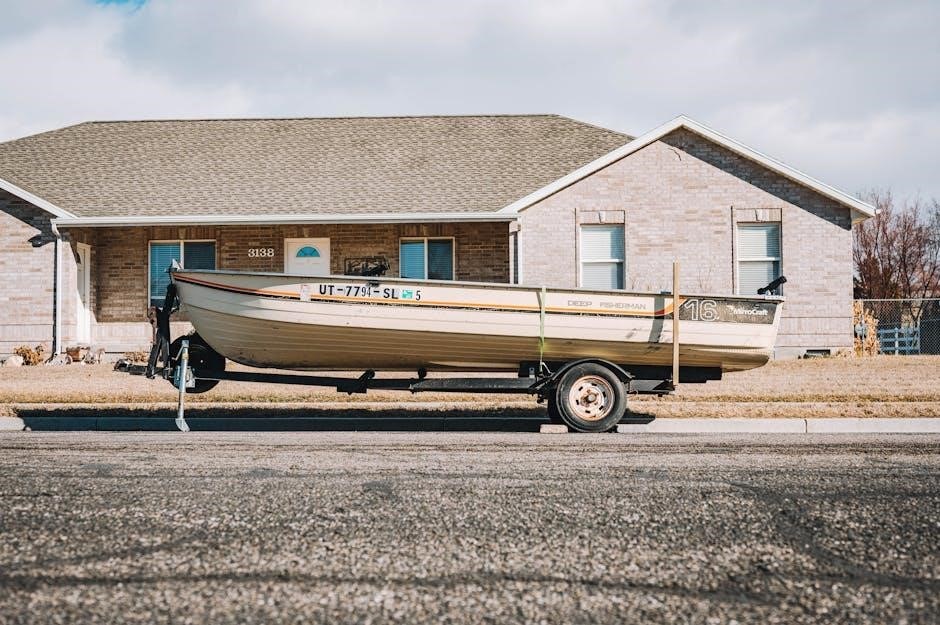boat trailer guide on bunks
Boat trailer guide-on bunks simplify loading and unloading by aligning your boat properly on the trailer, reducing damage and improving safety during the process.
Overview of Boat Trailer Bunks and Their Importance
Boat trailer bunks are essential components designed to support and cradle your boat while it’s on the trailer. These bunks, typically made of carpeted wood or plastic, protect the boat’s hull from damage and provide a stable surface for loading and unloading. Properly installed bunks ensure the boat is evenly distributed across the trailer, preventing uneven stress that could lead to hull damage. They also play a crucial role in reducing movement during transit, ensuring safety while towing. By guiding the boat into position, bunks simplify the loading process, especially in windy or choppy conditions. Regular maintenance of bunks is vital to ensure they remain effective and continue to safeguard your boat during transportation.
Benefits of Using Guide-On Bunks for Boat Trailers
Guide-on bunks offer numerous advantages for boat trailers, enhancing both functionality and safety. They simplify the loading and unloading process by providing clear alignment guidance, reducing the risk of hull damage. These bunks minimize the frustration of maneuvering the boat onto the trailer, especially in windy or choppy conditions. By guiding the boat into position, they ensure a smoother and more efficient process. Additionally, guide-on bunks provide stability during transit, preventing excessive movement that could lead to scratches or dents. They are durable, long-lasting, and easy to install, making them a practical upgrade for any boat trailer. Overall, guide-on bunks are a valuable investment for boat owners seeking convenience, protection, and peace of mind while trailering their vessel.

Types of Boat Trailer Guide-On Bunks
Boat trailer guide-on bunks come in two primary styles: bunk-style and post-style. Both designs provide alignment guidance but cater to different trailer setups and boat sizes.
Bunk-Style Guide-Ons for Boat Trailers
Bunk-style guide-ons are designed to straddle the boat, providing lateral support and alignment assistance; They are typically mounted on the trailer frame and feature a sturdy construction, often with carpeted or padded surfaces to protect the boat’s hull. These guide-ons are ideal for boats with wider hulls or those that require extra stability during loading. Installation involves attaching them to the trailer’s bunk brackets, ensuring they are level and properly aligned with the boat’s hull. They are available in various lengths, such as 4-foot and 5-foot options, to accommodate different boat sizes. Bunk-style guide-ons are a popular choice due to their durability and effectiveness in simplifying the loading process.
Post-Style Guide-Ons for Boat Trailers
Post-style guide-ons are vertical or upright structures mounted on the trailer frame, designed to assist with boat alignment during loading and unloading. They typically feature tall, sturdy posts that provide visual and physical guidance, helping to center the boat on the trailer. These guide-ons are often equipped with rollers or pads to gently guide the boat into position without causing damage. Post-style guide-ons are ideal for larger boats or for use in low-light conditions, as they offer clear visual cues. They are adjustable to accommodate different boat sizes and shapes, ensuring proper alignment every time. Installation involves securing the posts to the trailer frame, often near the rear or front, depending on the setup. Durable and easy to maintain, post-style guide-ons are a practical solution for enhancing trailer functionality and safety.
Installation Process for Boat Trailer Guide-On Bunks
Install guide-on bunks by removing old boards, measuring, marking, and drilling pilot holes. Secure with bolts, ensuring proper alignment and adjustment for optimal boat support and alignment.
Step-by-Step Guide to Installing Bunk-Style Guide-Ons
Begin by removing the old bunk boards and use them as templates to mark hole positions on the new ones. Drill pilot holes to prevent splitting. Mount the new bunks into the trailer brackets, ensuring they align with the boat’s hull. Tighten the bolts securely but avoid overtightening. Position the guide-ons along the bunks, spaced evenly to cradle the boat’s sides. Attach them using the provided hardware, adjusting their height and angle for proper alignment. Finally, test the setup by loading the boat onto the trailer to ensure smooth operation and correct positioning. This process enhances loading efficiency and protects the vessel from damage during transport;
Step-by-Step Guide to Installing Post-Style Guide-Ons
Start by removing any existing guide-ons and cleaning the trailer. Measure the width of your boat to determine the optimal post placement. Mount the base plates securely to the trailer frame using a wrench. Slide the guide-on posts into the mounts, adjusting their height to align with the boat’s hull. Tighten the bolts to ensure stability. Test the setup by guiding the boat onto the trailer to ensure proper alignment. Adjust the posts as needed for a snug fit. Finally, secure all components firmly to prevent movement during transport. This system provides visible guidance, making the loading process easier and reducing the risk of damage to the boat or trailer.

Positioning and Aligning Boat Trailer Guide-On Bunks
Measure the boat’s hull width and position the bunks to support its outer edges, ensuring proper alignment without gaps for secure and balanced boat placement.
How to Properly Position Bunks for Optimal Boat Alignment

Properly positioning bunks ensures your boat aligns seamlessly with the trailer. Start by measuring the boat’s hull width at its widest point. Place the bunks on the trailer frame, aligning them with the hull’s outer edges. Ensure the bunks are level and evenly spaced to provide consistent support. For optimal alignment, position the rear bunk slightly narrower than the front to guide the boat into place. Use the boat’s natural resting position on the trailer as a reference. If using guide-ons, mount them on either side of the bunks to help center the boat during loading. Adjustments may be needed based on the boat’s specific shape and size. Proper positioning prevents imbalance and ensures safe, secure trailering.
Adjusting Guide-Ons for Different Boat Sizes and Shapes
Adjusting guide-ons ensures proper alignment for boats of varying sizes and shapes. Start by measuring the boat’s hull width and marking the trailer frame where the guide-ons will be mounted. Position the guide-ons so they align with the boat’s widest point, typically near the middle. For larger boats, wider guide-ons may be necessary, while smaller boats may require narrower adjustments. Use adjustable brackets or spacers to fine-tune the guide-ons’ height and angle, ensuring they gently guide the boat without causing damage. For boats with unique shapes, such as pontoons or V-hulls, additional padding or carpeting on the guide-ons can provide better protection and grip. Regularly inspect and adjust the guide-ons to accommodate any changes in the boat’s configuration or trailer setup.

Maintenance and Upkeep of Boat Trailer Guide-On Bunks
Regularly clean and lubricate guide-ons to ensure smooth operation. Inspect for wear and tear, and make adjustments or replacements as needed to maintain optimal functionality.
Cleaning and Lubricating Guide-Ons for Smooth Operation
Regular cleaning and lubrication are essential for maintaining the functionality of guide-ons. Start by removing dirt and debris using a mild detergent and water. Avoid abrasive materials that could scratch the surfaces. Once clean, apply a silicone-based lubricant to moving parts to reduce friction and prevent corrosion. This ensures smooth operation during loading and unloading. Additionally, inspect the guide-ons for wear or damage and address any issues promptly. Proper maintenance extends the lifespan of your guide-ons and ensures safe, efficient trailer use. By following these steps, you can keep your boat trailer guide-ons in optimal condition for years to come.
Inspecting and Replacing Worn-Out Bunk Guides
Regular inspection of bunk guides is crucial for ensuring optimal performance and safety. Check for signs of wear, such as frayed carpet, cracks, or rust on metal components. Inspect the brackets and mounting hardware for looseness or damage. If damage is found, replace the guides promptly to prevent further issues. When replacing, ensure the new guides match the original specifications for proper fitment. Use a wrench or socket set to secure the guides tightly to the trailer frame. Replace any worn-out carpeting or padding to maintain proper boat support. Regular inspections and timely replacements will help maintain the integrity of your trailer and ensure smooth boat loading and unloading. Proper maintenance also prevents costly repairs and enhances overall safety on the road and in the water.

